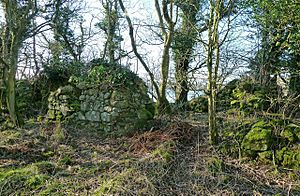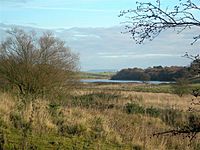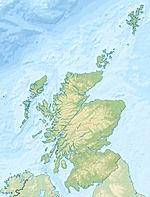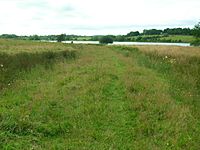Martnaham Loch facts for kids
Quick facts for kids Martnaham Loch |
|
|---|---|
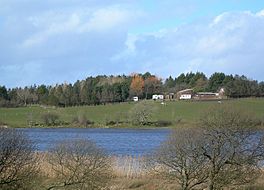
Martnaham Loch at Jelliston
|
|
| Lua error in Module:Location_map at line 420: attempt to index field 'wikibase' (a nil value). | |
| Location | Coylton, South Ayrshire, Scotland |
| Lake type | Freshwater loch |
| Primary inflows | Snipe Loch Burn, Sandhill Burn, rainwater and field drainage |
| Basin countries | Scotland |
| Max. length | 1+1⁄4 miles (2.0 km) |
| Max. width | 1⁄4 mile (0.40 km) at maximum |
| Surface area | 113 acres (46 ha) |
| Max. depth | 29 ft (8.8 m) |
| Water volume | 47×106 cu ft (1.3×106 m3) |
| Surface elevation | 269 ft (82 m) |
| Islands | One |
| Settlements | Ayr |
Martnaham Loch is a beautiful freshwater loch (that's a Scottish word for lake!). It sits right on the border between East Ayrshire and South Ayrshire in Scotland. This loch is about 2 kilometers (1.2 miles) from the village of Coylton and 3 miles from the town of Ayr. It stretches out from the north-east to the south-west. You can even see the ruins of an old castle on what might have been an artificial island in the loch!
Contents
History of Martnaham Loch
How the Loch Formed
Martnaham Loch is a large "kettle hole." This means it formed after the last ice age when a large block of ice melted and left a hollow in the ground. Water then filled this hollow. The loch gets its water from several streams, including the Sandhill Burn and the Whitehill Burn. It also receives water from Snipe Loch, which is connected to Loch Fergus. The water flows out of Martnaham Loch from its south-west end.
What's in a Name?
The name Martnaham has been spelled in many ways over time, like Martinham and Martnam. Experts aren't sure if the name comes from an old English language (Anglian) or from Scottish Gaelic. Some people wonder if it's connected to Saint Martin of Tours, but there's no proof of that.
Martnaham Castle: An Island Stronghold
You can still see the ruins of an old castle, called Martnaham Castle, near the middle of the loch. It was built on an island, which was connected to the land by a stone path or causeway. This causeway allowed people to reach the castle from the south side of the loch.
We don't know exactly when the castle was built, but people lived there until the 16th century. The ruins show a large main building and the foundations of a smaller building next to it. The walls are made of stone and are quite thick. The way it was built suggests it might be from the 16th or 17th century. There might have even been a gatehouse at the start of the causeway. The area around the castle has been covered in trees for many years.
Martnaham Castle might have been part of a line of forts that helped defend the area. Some stories even link it to an old legend about "Old King Cole." In the 1650s, the castle is said to have been attacked. An old writer, Groome, described it as "ivy-clad ruins of an old mansion house."
In the 1860s, a writer named Paterson shared some interesting details. He said that only parts of three walls were left. The castle's safety came from being on an island. The causeway could be cut off if needed. He also mentioned that the island itself seemed to be made of "forced earth," meaning it was built up by people. It was thickly planted with trees, and crows had lived there for ages. There's a legend that the castle's garden soil was brought from France or Ireland to keep away pests!
Crannog Connection
The island where Martnaham Castle stands, along with its causeway, looks a lot like a "crannog." A crannog is an ancient artificial island, usually built in shallow water, often used for homes or defense. Many other lochs in Ayrshire have similar crannogs.
Wildlife and Nature at Martnaham Loch
The western part of Martnaham Loch is a special protected area called a Site of Special Scientific Interest (SSSI). This means it's important for its natural features. The south-western end of the loch is surrounded by a mix of different trees.
Birdlife at the Loch
Martnaham Loch is a fantastic place for birdwatching! Many rare birds have been seen here over the years, like the smew, ring-necked duck, and black tern. In autumn and winter, you can see large groups of ducks like goldeneye, wigeon, pochard, and teal. Other ducks like shoveller and gadwall are also common. Sometimes, rare gulls like the glaucous and Iceland gulls visit.
You'll often see Canada geese and whooper swans in the nearby fields. Great crested grebes and little grebes even build their nests here. Many wading birds like oystercatcher, curlew, and redshank are regular visitors.
Plants and Trees
Martnaham Loch is rich in different types of plants. Martnaham Wood, on the eastern side of the loch, is one of the biggest oak woods in Ayrshire. Even though most of its trees were cut down in 1914, it has grown back naturally.
Around the edges of the loch, you'll find large areas of tall reeds. In the water, you can see beautiful white and yellow water-lilies. However, there's also a lot of Canadian pondweed, which is an invasive plant that can take over. The loch has a good balance of nutrients, but it also shows signs of being very rich in nutrients, which can sometimes cause too much plant growth.
Martnaham Wood is an ancient woodland, meaning it has been a forest for a very long time. It has oak and birch trees, with lots of hazel bushes underneath. You can also find wildflowers like bluebells. The wood is home to many different types of fungi, mosses, and liverworts. A very rare mushroom, Mycena picta, was once found here, and it was thought to be extinct in Great Britain!
Uses of Martnaham Loch
Purclewan Mill
At the south-west end of the loch, stones were used in 1906 to direct water into a channel (called a lade) that fed Purclewan Mill. This mill was important for the local community.
The famous Scottish poet Robert Burns is said to have written his very first poem, "Handsome Nell," at this mill. He might have been inspired by Nelly Kilpatrick, the miller's daughter. The mill is no longer active and has been turned into private homes.
Martnaham Lodge
Martnaham Lodge was built in the 1800s as a fishing lodge by the Kennedy family, who were Earls of Cassillis. It was later expanded. James Edward Shaw, an important local official, lived there for many years. The lodge is now a beautiful home with an Arts & Crafts style.
Fun on the Ice and Water
In the 19th century, Martnaham Loch was a popular spot for curling and ice skating when it froze over. Even in 2011, the ice was thick enough for safe ice skating again! Old maps show that there were two boathouses on the western side of the loch, meaning people enjoyed boating here too.
More About the Area
A mineral railway used to run very close to the eastern side of the loch. It served a coal mine in Coylton. The name "Whitehill Tilery wood" reminds us that there was once a tile-making factory in the area during the 1800s.



